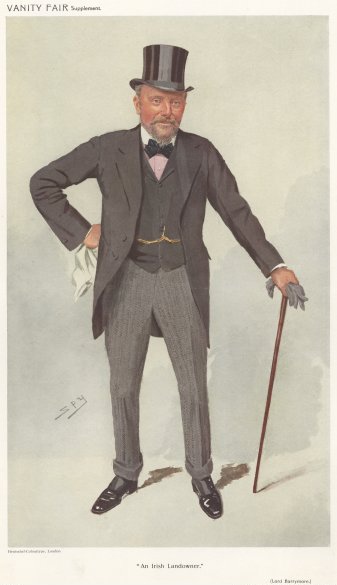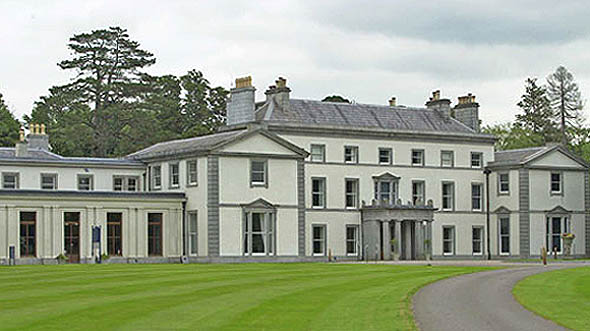Pauline Roche (1835 -1894) has been part of the story for a while, she married William Henry Barry in 1857. I’m becoming increasingly sure that she helps place a lot of things into context. This is one of a series of posts covering her marriage into the Barry family, and her daughter’s marriage into the related Smith-Barrys, and a look at where they all fit into both Irish, and British society. Pauline Roche is Ernest O’Bryen’s first cousin
The Smith-Barrys seem thoroughly respectable, certainly by the time Mary Barry [Pauline and William Barry’s daughter] marries into the Smith-Barry family in the summer of 1894. This was shortly before the death of her mother in the autumn of the same year. Both the marriage, and death are recorded in the civil registration district of Midleton, in county Cork, so almost certainly happened at the family home at Ballyadam.

This extract from “Barrymore Records of the Barrys of County Cork from the Earliest to the Present Time, With Pedigrees. London:” published 1902 rather smugly describes Mary Barry as follows
“Mary, married Cecil Smith Barry, second son of Captain Richard Smith Barry, of Ballyedmond, and first cousin of the Hon. Arthur Hugh Smith Barry, P.C. [now Lord Barrymore];”
Arthur Smith-Barry was created a peer, as Baron Barrymore, of Barrymore in the County of Cork, in 1902 the same year the Barrymore Records were published. I think there is a fair element of snobbery at work here in claiming kinship with a peer of the realm. By the late 1890’s, the Smith-Barrys were still firmly part of Ascendancy society, landed, wealthy, and members of the Church of Ireland. Arthur Smith-Barry was a major land-owner. He had almost 13,000 acres in co. Cork, and co.Tipperary.

He was the owner of Fota House, in co.Cork, as well as the family’s estates in England, based around Marbury Hall in Cheshire. In 1901, he is maintaining a large household at 20 Hill Street, in Mayfair, with a butler, valet, governess, cook, five maids, two footmen, and a hall boy; about the same number that Lord Grantham kept in Downton. The slight difference being the Smith-Barry family consisted of Arthur, his wife Elizabeth, and their six year-old daughter Dorothy.
In a slight contrast, his first cousin Cecil, and Mary Smith-Barry were living in a reasonably sized house in Castlemartyr, Cork in 1901. They had ten rooms, and a couple of stables, and a coach house. The household comprised of Cecil, and Mary, their five year old daughter Cecily Nina, and a twenty three year old house and parlourmaid, Julia Casey. Ten years later, Mary had moved to a smaller house about ten miles away at Ballynoe, on the outskirts of Cobh. She is forty-five years old, and has been a widow for three years. The house is rented from her late husband’s cousin Lord Barrymore, who seems to own most of the village. Mary seems to be living quietly in the village with her daughters Cecily who is now fifteen, and four year old Edith, and a nineteen year old servant girl.
To put things in perspective, when Cecil died in 1908, he left just over £ 5,000 [ the best current-day equivalent is £ 3.2m]. In the same year, The Old Age Pensions Act 1908 introduced a non-contributory pension for ‘eligible’ people aged 70 and over. The pension was 5 shillings a week, about half a labourer’s weekly wage, or £ 13 p.a. Cecil’s £ 5000 was the equivalent of three hundred and eighty four years of old age pension, so they were hardly paupers.

Arthur, by contrast, was ludicrously rich. Quite how he, and his family kept it all is quite astonishing. Fota House was sold, after his granddaughter’s death in 1975, to University College Cork, and is now part of the Irish Heritage Trust.
However the past history of the Smith-Barrys is rather more chequered than this rather respectable pedigree would lead us to expect. John Smith-Barry, Cecil and Arthur’s grandfather was born illegitimately in 1793; though to be fair to his father James Hugh Smith Barry (1748-1801), James lived openly with Ann Tanner, the mother of his children, and made arrangements for them to be legitimised, and to take his name, coat of arms, and to inherit. James S-B was even richer than Arthur Smith-Barry, and actually the source of much of Arthur’s money.
Following the death of his father John Smith Barry in 1784, James Hugh Smith Barry inherited Belmont Hall, in Cheshire, and continued to live there. Three years later, on the death of Richard Barry [his uncle] in 1787, James Hugh Smith Barry also inherited the family’s estates in Cork, and Tipperary, as well as the Marbury estate, in Cheshire, next door to Belmont. As a young man on the Grand Tour, between 1771-6, he travelled widely in Europe and the Middle East, borrowing large amounts of money and amassing a huge collection of ancient statuary, vases and paintings, mostly by Italian Masters, but he also had a couple of Van Dykes, I think a Reubens, and at least one Caravaggio.
James Hugh Smith Barry (1748-1801), may have lived openly with Ann Tanner, the mother of his bastard children, but at least he lived with them rather more respectably than his first cousin’s family. Richard Barry, 6th Earl of Barrymore (1745-1773) appears to be reasonable, but his children were about the most dissolute, feral people anyone could meet, and Richard Barry’s parents-in law, William Stanhope, 2nd Earl of Harrington and Lady Caroline Fitzroy were about as bad as their grandchildren.